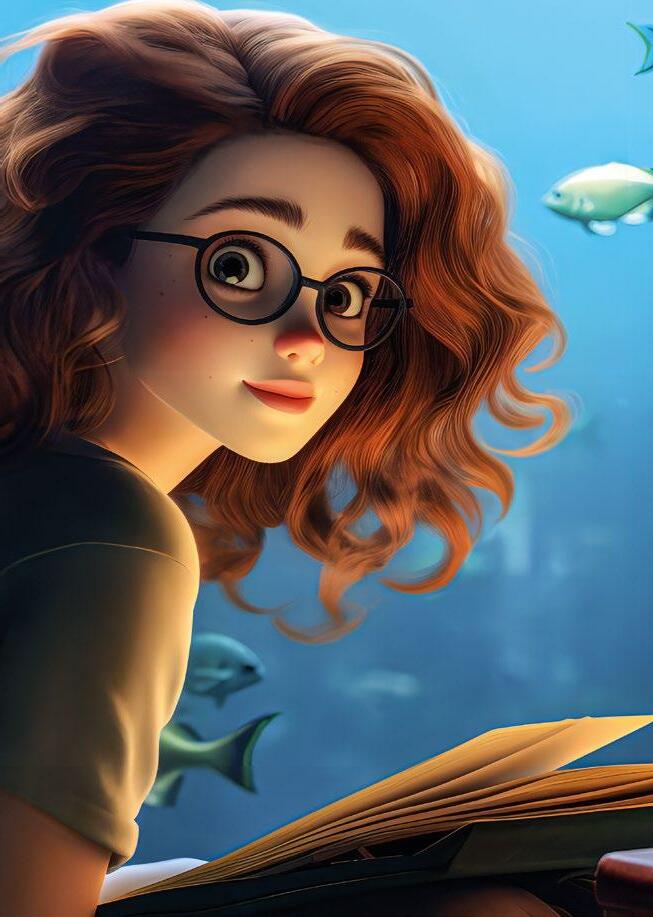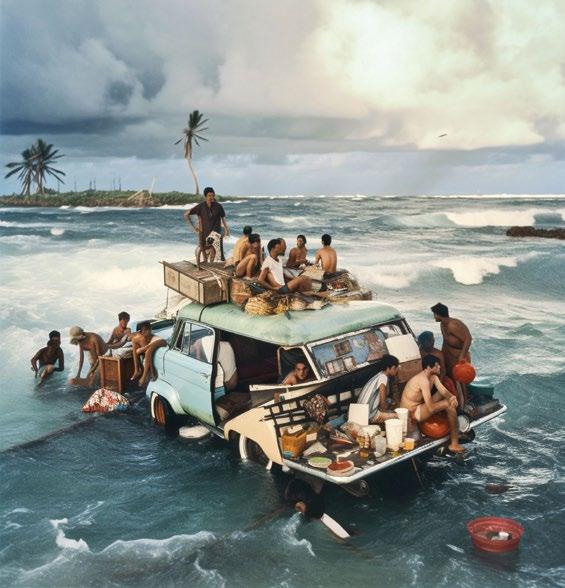
9 minute read
Who's Afraid of Artificial Intelligence?
Who's Afraid of Artificial Intelligence?
We increasingly encounter images that so resemble photography as to throw doubt on its veracity.
BY ROBERTO KOCH — PRESIDENT OF CONTRASTO
According to historian Geoffrey Batchen, before photography became a genuine invention it started as a desire to convert into permanent form images captured in the dark room. In a recent article, Chiara Bardelli Nonino mentions the recollection of Susan Sontag that in 1850 (only eleven years after the official recognition of the birth of photography), astronomers captured an image of the star Vega on a plate. The light that formed the image left Vega, twenty light-years away from Earth, before the invention of photography was revealed to the world. The author comments that it is easy to understand how the combination of reality and photography, which has made the latter increasingly fascinating, has always been at the root of our aspirations and anxieties, as it still is. The technological evolution of systems for representing reality, especially those related to photography, has seen significant growth and development, especially in recent times. The rise of artificial intelligence (AI) has meant that our lives and imagination have begun to experience intrusion by systems that closely resemble photography, leading us to doubt about its existence.
Let's try to clarify things. The ability of AI to create apparently genuine images poses almost insurmountable problems regarding the credibility of information. It means that readers need defence mechanisms that allow them to distinguish between visual information that is genuine and simulations created by techniques and methodologies unconnected to representations of reality captured through classic analogue methods. Instead, these new techniques rely on interpretation and imagination.

The term "Artificial Intelligence" was coined in 1956, and following decades of growth of data processing, improved storage capabilities and the development of advanced algorithms, AI can now mimic human reasoning.
AI is a computer system that learns from experience. It can adapt to new inputs, performing tasks in a manner similar to a human being. The definition of AI has evolved over the years, as have the applications that employ this technology.
AI creates almost insurmountable problems regarding the credibility of information
AI can sometimes be seen as sinister. Science fiction stories have led us to see it as a potential threat to human existence, possibly in the near future. However, AI is actually a generally harmless innovation, although it may have controversial consequences. If we are to use it safely, we must be aware of how it differs from photography.
The winners of the Sony World Photography Awards (SWPA), one of the world's most followed annual photography competitions, were announced recently. Victory in the "OpenCreative" category for single images created by both professional and amateur photographers, went to a black and white image titled "PSEUDOMNESIA | The Electrician" submitted by German photographer Boris Eldagsen. The jury described it as "an unsettling black and white portrait of two women that evokes the visual language of family portraits of the 1940s".
Eldagsen's victory sparked a debate in the press and on social networks because the image was not captured with a camera but generated with Stable Diffusion, an advanced AI-based technology, which uses commands in the form of text to create images.
Following the announcement of his victory, Eldagsen decided to turn down the award, raising questions about the definition of photography and stating that he could not accept it since AI is not photography. With regard to information photography, we have had to deal with fake views for many years – reportages or individual images disseminated solely to artificially generate false news, which is often supported by deliberately falsified photographic evidence. This has severely tested media credibility in recent years.

A few months ago, The New York Times denied ChatGPT, an AI chatbot, the unpaid use of its articles to train the application's algorithms in the creation of more powerful and realistic images. Various successful entrepreneurs behave inconsistently on this issue. Elon Musk, for example, after opposing AI for a long time and stating that it could lead to the failure of many companies, has now created his own AI company, XAI, to control it.
Extraordinarily realistic images (even if revealed to be not real) can be produced using AI software without the need to visit a location, thereby challenging the principle that applies to all photographs according to Roland Barthes – simply, that what we see "once was". It doesn't apply to AI, because what we see possibly "never was". On the other hand - as Joan Fontcuberta correctly points out in her latest book "Against Barthes" - in 1989, the year when the fall of the Berlin Wall changed the world in a new and extraordinary page of history, photography was also undergoing a revolutionary transformation. At the beginning of 1989 two brothers, Thomas and John Knoll, sold Adobe System Inc. the licence for the first version of a photo processing and retouching software called Photoshop, giving birth to what came to be called post-photography, which saw huge development in subsequent years. Photoshop has become synonymous with the artistic manipulation of photographic images, effectively "transforming" them while leaving no visible evidence.
The problem we face is how to enable readers to identify questionable aspects in different methods of presenting information. In analysing any image we definitely need to acknowledge that photographs, almost by definition, always lie insofar as they show a representation, not truth. A degree of healthy scepticism is therefore always wise.

Another important factor is the credibility and authority of the creator of the images we are considering. Credible information is more likely to come from someone already trusted for other reasons rather than from lesser-known and less reliable sources. But we can be helped in this if we understand the use of the term "intelligence" and examine how it applies to the processing and production of images.
Intelligence is a specifically human function with various features, one of which – absent in AI - is that healthy sense of flexibility and adaptability revealed by objective examination of intelligent behaviour. It is a quality that is virtually exclusive to human beings, whose actions are guided by their minds and not by abstract algorithms. Only experience can help us develop the autonomous judgment to guide our investigations.
The principle that applies to all photographs – simply, that what we see "once was", is thereby challenged
The work of Michael Cristopher Brown, an internationally well-known photographer and a respected member of Magnum in past years, has generated much discussion in recent times. He sees himself both as a photojournalist and as an artist who uses AI as a storytelling tool, and always specifies the limits and characteristics of his work. For his Instagram site he has created various AI images of Cuba, a country he knows very well, at least visually.

These images (one of the purposes was to sell the entire series as NFTs) show an impressive realism that combines the power of Cuba's historical legacy with Michael's experience as a photographer. The result is a "storytelling" project, as the author describes it, i.e. a work of fiction, an autonomous narration, although it may appear to be documentary photography. The visual narrative focuses on situations in which it is impossible to participate as a witness - an essential prerequisite for any photojournalist - as is true of any episode, past or future. Michael Cristopher Brown uses personal memories, impressions developed over years travelling and living in Cuba, along with the storytelling and memories of the protagonists, to generate a fictional narrative close to reality, constructed from images rather than words.
The principle that applies to all photographs – simply, that what we see "once was", is thereby challenged
Perhaps what should guide us in all our judgments is the realisation that any conflict between AI and photography is fundamentally a misguided battle that can never be won. A speeding train cannot be stopped with bare hands. Similarly, we cannot and should not hold back the future or the development of technology, but should instead ensure that we use the tools at our disposal with awareness of the limits and potential of the two languages, so similar but so different, of documentary photography and AI creations.
However, the number of instances in which AI has invaded the field of information with false visual news or creations promoting a view or an objective is high and growing. They include propaganda such as the fake arrest of Trump and, in the same week, an image of the Pope wearing a white feathered jacket. Many artists have experimented with the use of AI to create similar images.
The result is a “storytelling” project, as the author describes it, i.e. a work of fiction
In another field, the cinema, the strike by Hollywood writers in protest against AI competition is creating considerable unease, with the two sides taking increasingly extreme positions. We must ensure that future developments can be managed with intelligence, perhaps human rather than artificial. We all stand to gain from this, as will photography itself, which, although its survival has been under threat for decades, has reached an unprecedented level of popularity that demonstrates its extraordinary and inexhaustible vitality.











